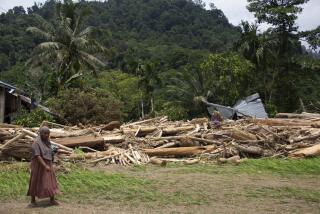Land or Sea, Indonesia Enchants
PADANG, Indonesia â Bogowonto is a cargo ship converted to a passenger-carrying vessel. The conversion consists of taking the cargo off and putting the passengers on.
Upon boarding I thought, âTwo days and nights of this may be unbearable.â Yes, deck-class. Hundreds of others and me. Because I was one of the last to board, I got the leftovers as far as deck space was concerned. And gray skies promised to rinse the decks.
The port of embarkation is Jakarta, capital of Indonesia on the island of Java. Destination Padang, on the jungle-filled island of Sumatra. We would go through the narrow Sunda Strait between the two islands, passing the famed volcano Krakatau.
In such close quarters it doesnât take long before one makes many new friends.
At the first meal I realized I should have brought my own bowl and eating utensils. Just as I realized this, an Indonesian woman saw my situation and produced the necessities from her bag of goodies. Using sign language, she conveyed to me that I could return them to her at the end of the voyage.
Feeble Attempt to Stay Dry
I thanked her and headed to where food was being served. When I handed my new bowl to the cook, he filled it with rice topped off with bits of fish. That was my dinner, and it was repeated for every meal thereafter.
With the first evening came the wind and rain. Having no blankets or sleeping bag, I curled up atop some heavy ropes and covered myself with my parka in a feeble attempt to stay dry and get some sleep. I managed neither. But every time I peeked out from under my parka I saw the Indonesians also wide awake, and wet, and smiling.
Halfway through the night I got up and found a few old wooden crates. With the assistance of some of the men nearby, we built a makeshift windbreak. Although it helped, I still didnât manage a wink of sleep all night.
It was almost sunup when my immediate neighbor signaled me to come out from under my parka. My eyes followed the direction he pointed and in the distance was Krakatau. In August, 1883 the volcanic cone that rose more than 2,600 feet above the sea erupted, creating 130-foot tidal waves that claimed 36,000 lives. The eruption was heard 3,000 miles away and sent volcanic dust into the air that lingered for a year before settling.
By mid-morning the storm clouds made way for clear skies for us. I spent most of that day looking from the rail of the ship at Sumatra on the right or the vast Indian Ocean on the left, and reflected on the enchanting islands of Bali and Java we were leaving behind.
Village of Painters
In the cool hills, slightly south of the center of Bali is the village of painters, Ubud. Its main street has an eatery where I got involved in Gado-Gado (an Indonesian salad with a tasty peanut dressing) while sitting at a shaded outdoor table enjoying the tropical weather.
Off the main street run many side streets where dozens of losmen or homestays are. These offer basic accommodations, usually run by a family living on the premises. More often than not you feel more like a guest of the family than a hotel guest.
I chose a place called Jatiâs Homestay, a 10-minute walk down a dirt road to the center of town. Jati is a painter who has his studio on the premises where I spent time drinking tea and watching his nimble hands. He created a painting of laborers bent over in the rice fields beginning to harvest what seemed to be endless rows of paddies. From my room I saw the sun dancing off the brilliant green water-filled rice paddies that were terraced down the hill behind the homestay.
The dirt road heading away from town took me through a monkey forest. Indonesian children sell food to feed the monkeys. Following small paths through the forest, everywhere I saw monkeys play and swing, scratch one another or just watch me. Having spent some rupiahs on monkey food, I learned how persistent they are, even climbing into my tote bag to search for snacks.
Continuing on the main path leading out of the monkey forest are more losmen. In many of these, artists paint landscapes and other scenic paintings inspired by the tranquillity of Ubud and its picturesque surroundings.
Stopping to watch some, I found the path that looped me back to the main street on the other side of town. I continued on a bridge over a slow-flowing river.
No Stopping to Rest
At first I thought my eyes were deceiving me. Down at the bottom were four women starting their way up a steep switchback trail that would eventually lead them to where I was standing. On their heads, each balanced two rocks. Weâre talking two-foot diameter rocks that I would struggle just to lift head high.
I watched them walk back and forth all the way up without stopping to rest. These young women with their colorful wraparound sarongs made the climb look effortless.
After about 10 minutes they reached the top. They could see that I was watching them in both amazement for what they had done and in confusion as to why they did it.
After they put down the rocks and we exchanged smiles, accompanied by giggles on their part and a shrug of shoulders on mine, they explained what they were doing by making motions of using a hammer to smash the rocks, and then pointing to the dirt road indicated what the rocks were to be used for.
Returning to my homestay late that afternoon, Jati invited me to see his brother perform some Indonesian dances later that evening.
In an old stone temple I was escorted to an inner open-air courtyard. The gamelan orchestra, mainly percussion instruments, produced a sound that is best described as lower notes keeping rhythm behind a cacophony of higher notes that at times become subtle only to break back into frenzy.
The dancers appeared in costumes of gold brocade, batik (a colorful material made by a repeated process of waxing and dyeing) and various headdresses. The combination of dancers and gamelan engulfed my senses. As the gamelan worked into a frenzy, so did the dancers, bending their thin fingers backward as they twitched wildly. Their eyes rolled back and forth and around, making them seem almost inhuman.
Visit to a Bat Cave
The next morning Jati rented me his motorcycle to visit Penelokan and the bat cave at Goa Lawah. After twisting and turning up the winding mountain road, I arrived at Penelokan, home of Mt. Batur and Lake Trunyan. Penelokan is on the high cliffs overlooking the volcanic basin and Lake Trunyan. A steep corkscrew road leads down to the lake. In 1926 Mt. Batur erupted, forcing the village to relocate from the basin floor to atop the cliffs at Penelokan.
The more energetic climbed to the rim of the volcano. I chose a relaxing boat ride across the lake followed by a swim in the lakeâs cool water.
At the entrance of Goa Lawahs bat cave is a temple with shrines. At first glance, the walls of the cave seem to be black. I soon realized that the black walls are thousands of bats clinging to the cave.
To the west of Bali separated by the narrow Bali Strait lies the most populous island in Indonesia. Although Java is less than 7% of Indonesiaâs area, it contains two thirds of the total population (160 million).
I made my way to the bow of the Bogowonto and watched the sun drop below the horizon. The clear sky over the ocean went from blue to fiery orange and red before turning into a black backdrop for thousands of shining stars. Our second and final night aboard was beginning.
Music Knows No Barriers
One of the locals produced a guitar. Once again the fact that music knows no barrier was proved. Out of my bag I took the pair of drumsticks I always carry. I found the wooden crates and decks sufficient for tapping on. As in most of Asia, people love to sing. It matters not how melodically one can, or cannot sing.
So, for hours, the guitar player strummed, I tapped, everyone sang and the children danced. We played everything from traditional Indonesian music to modern Indonesian pop. And out of respect to me and my language they insisted on âJingle Bellsâ and âHappy Birthday to You.â
After a great nightâs sleep I returned my borrowed bowl and said farewell to my new friends. Our ship entered Padang. I had barely enough time to get to the airport for my plane to Malaysia.
âWhat do you mean, no reservation? I confirmed a seat while I was in Jakarta,â I said.
âSorry, sir. No reservation. The planeâs booked up and it will be gone in a few minutes.â And then the Indonesian smiled.
âFive dollar?â I offered.
He shook his head.
âTen?â
He nodded, gave me my boarding pass and I boarded the half-empty plane as he slid the note into his pocket.
More to Read
Sign up for The Wild
Weâll help you find the best places to hike, bike and run, as well as the perfect silent spots for meditation and yoga.
You may occasionally receive promotional content from the Los Angeles Times.






